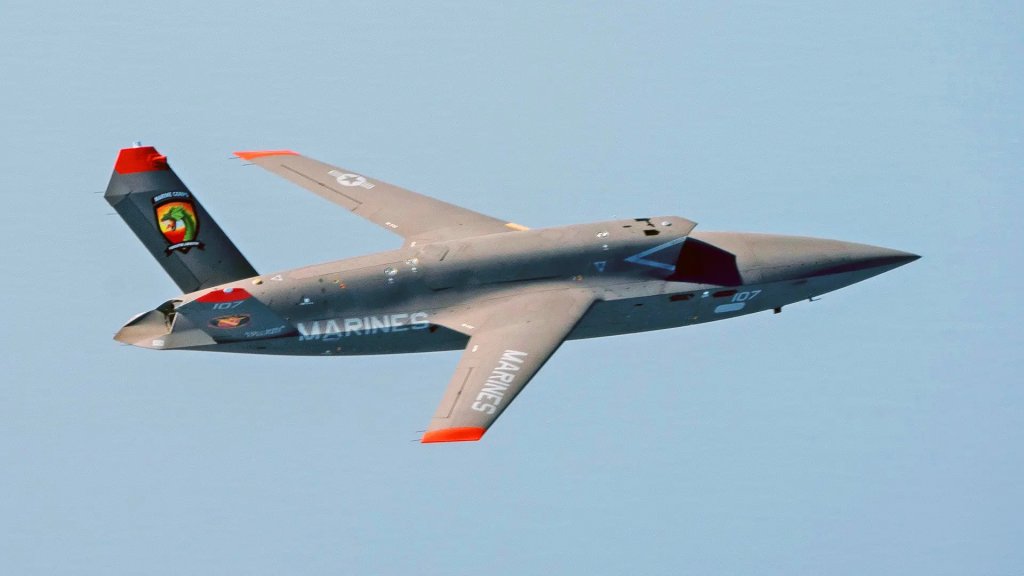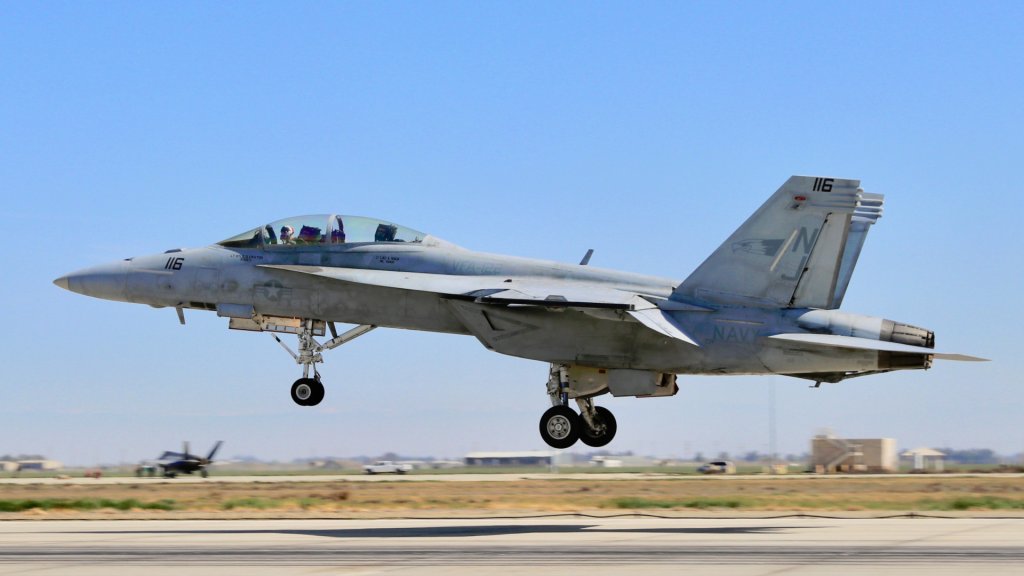Naval aviators need to be able to trust any future drone wingmen as much as their human counterparts, a U.S. Navy strike fighter tactics instructor has told TWZ. This echoes past comments from members of the U.S. Air Force and U.S. Marine Corps, and is set to be a critical factor in turning the Navy’s still very nascent and evolving crewed-uncrewed teaming vision into a reality.
Navy Lt. Cdr. Mark “Tugboat” Jbeily talked about ‘loyal wingman’ type drones, now commonly called Collaborative Combat Aircraft (CCA), and crewed-uncrewed teaming, and how they factor into his service’s plans for future carrier air wings, with our Jamie Hunter at the Tailhook Association’s annual symposium today. Jbeily is a career F/A-18 pilot and TOPGUN graduate currently assigned as an instructor to the Strike Fighter Weapons School, Pacific (SFWSPAC) at Naval Air Station Lemoore in California.

“I think, currently, we’re [the Navy] still figuring out exactly what the specific type of [CCA] platform is going to look like, how it’s going to integrate into the air wing, [and] how we’re going to use it for maximal advantage,” Jbeily explained. “But I think some common themes … are going to be consistent regardless of the specific platform, range, vendor, whatever it is.”
“You know, the wings on your chest are a sign of trust, ultimately, right? They represent that you’ve been through an established training pipeline. You’re going to behave in a predictable manner, in a standardized manner. We can trust you with this awesome power of an F-18 or F-35,” he continued. “How do we take that concept of trust and now bring it to collaborative autonomy, or manned-unmanned teaming? How do we train to get them comfortable so, in the same way that if you and I were flying, if you were my wingman, I would know you’re going to behave in a repeatable, consistent [manner]?”
“I can have insight on your behaviors. We can do a thorough debrief about why did you do this or why did you do that?” Jbeily added. “And the key, I think, is going to be, regardless of the specific platform, how do we build that element of trust, and how do we get folks comfortable to be able to use it in a combat scenario if we have to.”
The video below from Collins Aerospace offers a vision of what a future conflict involving U.S. CCAs, including ones launched from carriers, teamed up with crewed fighters might look like.

When it comes to advanced autonomous capabilities, whether they be integrated into drone wingman or another platform, the essential need for trust has now been a common refrain from members of the U.S. military for years. This trust will be just as critical during routine training and other day-to-day activities involving crewed-uncrewed teams as it will be during any future combat scenario, for exactly the kinds of reasons that Lt. Cdr. Jbeily cited today.
At a separate conference earlier this year, a U.S. Marine Corps aviation officer highlighted how just making sure that CCA-type drones do not collide with their crewed companions remains a challenge. TWZ noted at the time that this underscored the many basic problems still to be solved before CCAs can be regularly deployed, launched, recovered, supported, and otherwise operated at all, let alone employed tactically.
In speaking with TWZ today, Lt. Cdr. Jbeily further talked about how CCAs could be incorporated in training in the future using what are called live, virtual, constructive (LVC) concepts. As the name indicates, LVC training blends together real and simulated elements in real-world and virtualized settings using a mixture of systems networked together, as you can read about in more detail here. LVC concepts are already regularly used as part of research, development, test, and evaluation activities related to advanced uncrewed capabilities. In line with his comments on trust, Jbeily put particular emphasis on the need for the live component.

“We already, within the Navy, have an established process of, if you take, for example, live-fires for missiles, air-to-air missiles, folks will go down to our test and evaluation ranges and actually live employ a real missile against some sort of drone or something,” he said. “And that is meant to build that comfort, so, ultimately, when game day comes, you’re not going to rise to another level, you’re going to fall back to your basic level of training.”
“I think that when you think about the Live, Virtual, Constructive piece of this, there’s absolutely going to be a component, because you’re never going to see these collaborative combat aircraft, potentially, right? They may be dozens or hundreds of miles away, even,” he continued. “So, there’s got to be a constructive bit, but I think, ultimately, if we want to get that comfort level of having another piece of metal in the sky that you either join on, or you trust to employ weapons, or you trust to execute your mission command, there has to be some element of live flight. What the specific combination will be and where we can realize optimizations, I think, is still kind of to be determined, but it’s a place that I think we can realize gains on both ends, both the live and the sort of virtual, constructive piece.”
On a broader level, the Navy still has yet to settle on a clear vision for how it will incorporate CCAs into its future carrier air wings and what forms those drones might take, as a result. In the past, the service has put forward a concept for lower-cost carrier-capable drone wingmen in the past that envisions them being “consumable,” and expended as one-way kamikaze drones or aerial targets for training or testing use at the end of relatively short service lives. In recent years, the Navy has also openly talked about a more general goal to eventually see the aircraft in its carrier air wings become at least 60 percent uncrewed.
In addition, the Navy is party to a tri-service CCA agreement with the Air Force and the Marines, but, by its own admission, is trailing behind those services on all fronts. The Air Force currently has two CCAs – General Atomics YFQ-42A and Anduril’s YFQ-44A – under development, and is already looking toward future designs. The Marines are in the process of transforming their work with the XQ-58A Valkyrie into an operational capability.


The Navy’s current stated focus is on getting the MQ-25 Stingray tanker drone into service, which it hopes will lay the foundation for adding more uncrewed aircraft to its carrier air wings. The service has also expressed a strong interest in Boeing’s MQ-28 Ghost Bat, a loyal wingman-type drone.

“I think right now, within the experimental community, the VXs [air test and evaluation squadrons], there’s a lot of discussion there,” Lt. Cdr. Jbeily told TWZ today about what might be on the horizon drone-wise for the Navy. “I think that the Air Force has potentially taken the forefront on this with their Collaborative Combat Aircraft program.”
The Air Force’s CCA program does appear to be the leading effort in this vein across the services, as you can read about more in TWZ‘s past reporting.
“I think that those decisions about what we’re going to buy, when we’re going to buy it, are a little bit above my level, but I know that the Navy is still deeply interested in looking in terms of how we can, for the purpose of maintaining warfighter advantage, how we can keep the Navy and the Air Wing relevant with this sort of precision, mass and collaborative autonomy,” Jbeily added. “[The] Air Boss’s big initiative has been MQ-25 in ’25 to get sort of that specific aerial refueling platform, [to] lessen the burden on Super Hornets, which currently perform the aerial fueling role. So I think what that’ll end up being is a good model for how do we integrate autonomous systems into the air wing and ensure that we can get folks comfortable to accomplish these missions.”

The “Air Boss” that Jbeily is referring to here is Vice Adm. Daniel Cheever, head of Naval Air Forces. “MQ-25 in ’25” refers to the goal for the Stingray to fly for the first time before the end of this year, a milestone that has already been much delayed, reflecting larger schedule slips and cost growth for the program.
“There’s so much sense of urgency and purpose amongst our junior officers who recognize the peer competition that we’re in and recognize the role that the Navy will play in providing peace through deterrence, and we want to prepare for the future fight,” the strike fighter tactics instructor told TWZ today, speaking more generally. “That urgency that you see amongst the junior officers is focused on being the change and bringing the change, and not simply accepting business as usual.”
“We just want to keep the carrier relevant and effective, and that’s the energy that’s shared amongst junior officers.”
As noted, the Navy does see drones as a key element of its future carrier air wings. Ensuring that there is trust in those uncrewed aircraft to perform, especially among the junior officers who will be flying alongside them, will be of vital importance.
Contact the author: [email protected]
